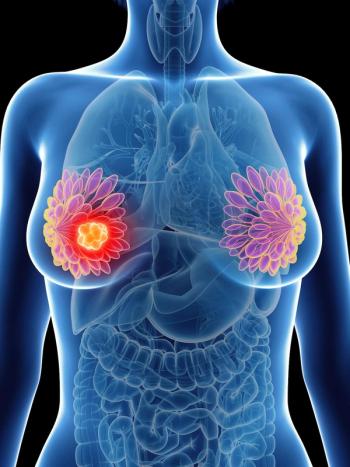
Oncology NEWS International
- Oncology NEWS International Vol 9 No 5
- Volume 9
- Issue 5
Snake Venom Protein May Control Breast Cancer Growth
DALLAS-The antitumor powers of a venom protein from the southern copperhead snake are being studied at the University of Southern California. Results of early studies suggest that the protein, contortrostatin (CN), combines antagonism of breast cancer progression and inhibition of angiogenesis, making it a unique agent for control of breast cancer growth and proliferation.
DALLASThe antitumor powers of a venom protein from the southern copperhead snake are being studied at the University of Southern California. Results of early studies suggest that the protein, contortrostatin (CN), combines antagonism of breast cancer progression and inhibition of angiogenesis, making it a unique agent for control of breast cancer growth and proliferation.
The studies used a metastatic breast cancer model, which involves implanting human breast cancer cells into the mammary fat pads of nude mice, principal investigator Francis S. Markland, Jr., PhD, said at the Susan G. Komen Foundation National Grant Conference.
The researchers found that palpable tumor masses developed in the mouse mammary tissue 2 weeks after cancer cell implantation, and that tumor cells spread to the lungs in untreated animals within 12 weeks. CN or placebo was injected daily into tumors in several different groups of mice. Following treatment, the tumor masses in the CN-treated mice were significantly smaller than those in the placebo-treated mice.
Even more exciting, the CN-treated group showed more than 70% inhibition of metastasis to the lungs, compared with the placebo group, Dr. Markland said.
Other findings so far:
CN blocked the attachment of breast cancer cells to proteins, which are essential components of blood vessel walls.
CN prevented cancer cell invasion through an artificial blood vessel wall.
CN inhibited new blood vessel formation induced by breast cancer cells after incubation on a chick embryo membranous respiratory organ (the chorioallantoic membrane), while placebo treatment did not (see Figure).
Pharmacology studies suggest that CN blocks the function of several subclasses of cell surface proteins known as integrins, which regulate the interaction of the cancer and vascular endothelial cells and their microenvironment.
The genetic code for CN has been isolated and deciphered, and a method of producing large quantities of the protein has been established using genetic engineering technology, Dr. Markland said.
The clinical potential of this research will be advanced by the development of targeted delivery systems that enable IV administration of the drug, he said.
Articles in this issue
over 25 years ago
HRT Not Associated with Lower Survival After Breast Cancerover 25 years ago
Age No Contraindication to High-Dose Therapy in Myelomaover 25 years ago
ASCO Urges Passage of Patient’s Bill of Rightsover 25 years ago
RT Not Necessarily an Impedance to Breast Reconstructionover 25 years ago
New Adjunctive Regimens for Breast Cancer Treatment Are Under Studyover 25 years ago
NCCN Prostate Cancer Practice Guidelines Revisedover 25 years ago
ERT Does Not Increase Endometrial Cancer Recurrenceover 25 years ago
Radiochemotherapy/Transplant in Low-Grade Lymphomasover 25 years ago
Fish Oil Supplements May Improve Cancer Therapies’ Effectivenessover 25 years ago
Study of Dying Cancer Patients Reveals Importance of RitualsNewsletter
Stay up to date on recent advances in the multidisciplinary approach to cancer.


















































































